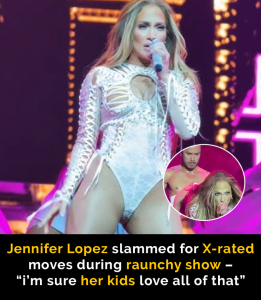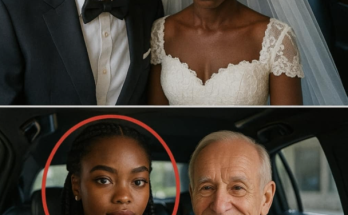Jennifer Lopez’s Raunchy Show Sparks Age-Shaming Backlash — But the Real Story Goes Deeper
At 55, Jennifer Lopez is no stranger to the spotlight. She’s danced through decades of global fame, from the Bronx to the Super Bowl, seamlessly blending music, acting, and fashion into a pop culture empire. But her latest performance — a sizzling, high-energy show during her This Is Me… Live tour — has ignited a fresh storm of criticism. The reason? Some viewers say the show was too “raunchy” for someone her age.
What followed was a fierce wave of online backlash — not just against her performance, but against her very presence as a woman in midlife commanding center stage with confidence, sensuality, and power.
But behind the clickbait headlines and judgmental comments lies a far more important cultural conversation.
The Performance That Sparked the Firestorm
It happened during a stop in Miami: Jennifer Lopez took the stage in a revealing, jewel-studded bodysuit. She performed choreography that mixed elegance with intensity — hair flips, sultry moves, and yes, a few hip thrusts that have become part of her signature.
The crowd inside the arena roared in support. But once videos hit the internet, the comment section turned harsh.
“Isn’t she a little too old for this kind of show?” one user wrote.
Another posted: “Someone tell Grandma JLo to sit down.”
A third: “She’s still trying to act like she’s 25. It’s embarrassing.”
The backlash had nothing to do with her talent or energy. It had everything to do with her age — and the expectations placed on women over 40, especially those in the public eye.
Double Standards in the Spotlight
The criticism wasn’t just cruel — it was deeply telling.
Male performers well into their 60s and 70s often take the stage shirtless, with grey beards, beer bellies, and guitar solos — and are hailed as “rock legends” or “timeless icons.” Think Mick Jagger, Lenny Kravitz, or even Bruce Springsteen. No one tells them they’re “too old” to entertain.
But for women like Lopez, who maintain their bodies, evolve artistically, and take control of their image, the rules suddenly shift. Instead of being praised for their longevity, they’re policed for daring to still be visible, sensual, and bold.
Why is society uncomfortable with women aging publicly — and refusing to fade quietly into the background?
Lopez: A Lifetime of Pushing Boundaries
Jennifer Lopez has never been someone to play by the rules others set for her.
From her breakthrough role in Selena to global pop success with hits like Jenny from the Block and On the Floor, she’s defied the limitations placed on Latinas in Hollywood. She’s headlined movies, launched business empires, danced in heels at the Super Bowl — and done it all while being unapologetically feminine, fashionable, and in control of her image.
She’s also faced decades of body-shaming, relationship scrutiny, and industry sexism. And through it all, she’s stayed relevant, resilient, and radiant.
So why should now — at 55 — be any different?
Fans Defend Their Queen
In the face of online attacks, fans quickly came to her defense.
“She looks better at 55 than most do at 25,” one fan wrote on X. “Let her live!”
Another added, “The only people upset about this performance are uncomfortable with a woman aging confidently and on her own terms.”
Across social media, hashtags like #JLoForever, #AgeIsJustANumber, and #RespectWomenOver50 began trending.
The response revealed a deeper truth: For every troll calling her “too old,” there are millions of people watching Jennifer Lopez perform and seeing what’s possible — how age doesn’t have to mean invisibility, restraint, or silence.
The Bigger Issue: Cultural Ageism
Experts in media and gender studies say what happened to Lopez is part of a broader issue.
“Women in entertainment are allowed to be sexy — but only within a narrow window,” says Dr. Nina Alvarado, a pop culture researcher at UCLA. “After a certain age, that freedom is taken away, and replaced with expectations of modesty and silence.”
This is rooted in the outdated idea that women must perform youthfulness to be valuable — and once they age out of traditional beauty norms, they must “know their place.” But celebrities like Lopez, Madonna, Halle Berry, and Angela Bassett are rewriting that script, simply by being themselves.
“They’re not trying to be young,” Alvarado adds. “They’re being visible, which threatens a society that still ties a woman’s worth to how much she can please others — especially men.”
JLo Responds — Without Saying a Word
Jennifer Lopez didn’t directly address the backlash. She didn’t need to.
She simply kept performing. She wore what she wanted. She smiled wider, danced harder, and sang louder. Her presence on stage became her response — a celebration of autonomy, artistry, and self-expression.
In her recent concert in Atlanta, she paused between songs and looked into the crowd.
“You know, I’ve been doing this for a long time,” she said. “And I don’t plan on stopping.”
The cheers were deafening.
Conclusion: Why This Moment Matters
Jennifer Lopez’s latest performance may have sparked controversy, but it also ignited a necessary conversation about age, gender, and agency.
In a world that still tries to dictate how women should behave at every stage of life, Lopez stands as a symbol of defiance and possibility. She isn’t asking for permission. She’s living fully, fiercely, and unapologetically.
And maybe that’s exactly what makes some people uncomfortable — not because of how she moves on stage, but because of what she represents: a woman owning her body, her voice, and her time.
So when the next wave of criticism comes — and it will — the best response might be the one JLo already gave:
A spotlight. A beat. A dance. And the decision to shine on, no matter what.

